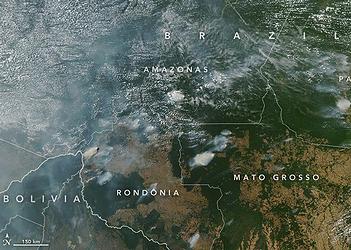
BRASILIA, Brazil, August 23, 2019 (ENS) – South America’s Amazon rainforest is burning in many places, blazing away so fiercely that the fires are visible from space. Smoke from the fires, mostly burning in southern Brazil, has reached Brazil’s largest city, Sao Paulo, more than 1,700 miles away.
This year’s Amazon wildfires came to the attention of scientists the world over after Brazil’s National Institute for Space Research (Instituto nacional de pesquisas espaciais – INPE) released the fact that at least 75,336 wildfires occurred in the country from January to August 23, 2019 – the highest number of wildfires since 2013 when INPE began to collect the data, using satellites to monitor fires.

Satellite data has shown an 84 percent increase in fires compared to the same period in 2018, INPE says. As of August 20, there were fires burning in the rainforest in four Brazilian states: Amazonas, Rondonia, Mato Grosso and Para, according to the U.S. National Aeronautical and Space Administration, NASA.
“We will act strongly to control the fires in the Amazon,” Brazil’s President Jair Bolsonaro said in a statement on national radio and television today.
He acknowledged that the Amazon rainforest must be protected. “We are aware of this and are working to combat illegal deforestation and any other criminal activities that put our Amazon at risk,” Bolsonaro said.
The president pointed out that, for this reason, the Federal Government offered aid to all states of the Legal Amazon. “The extensive use of personnel and equipment by the Armed Forces, auxiliaries and other agencies will not only allow to combat illegal activities but also to curb the spread of fires in the region,” he said.

Bolsonaro called for calm in dealing with the matter and said that “spreading unfounded data and messages, inside or outside Brazil, does not contribute to solving the problem, and lends itself only to political use and misinformation.”
The world’s largest tropical rainforest, the Amazon covers 40 percent of South America. Fed by thousands of rivers, it grows in parts of nine countries, covering 5.5 million square kilometers (2.1 million square miles).
As the largest moist tropical rainforest in the Americas, the Amazon rainforest is inhabited by an unparalleled variety of plants and animals. One in 10 of the world’s known species lives in the rainforest – the largest collection of living plant and animal species in the world, according to the Worldwide Fund for Nature, WWF.
A new plant or animal species is discovered in the Amazon rainforest at least every two days, and all species must share the region with more than 30 million people.
But now, the raging fires are forcing troupes of monkeys and flocks of birds to flee for their lives as their home groves burn, leaving them homeless.
The Amazon acts as a large carbon sink, absorbing up to a quarter of all the carbon dioxide (CO2) that forests absorb each year. And in a process known as CO2 fertilization, with increasing carbon concentration in the atmosphere, current models suggest that there will also be increased forest absorption for many years.
“However, this capacity of the forest to absorb atmospheric CO2 is not infinite,” says Celso Von Randow, a researcher at INPE’s Earth System Science Center. “To explore how the forest can respond to various environmental changes, a valuable tool is to combine field experiments with simulations of terrestrial biosphere models.”
The nonprofit Rainforest Alliance, based in California, explains that the fires are caused in part by farmers clearing land to expand agriculture. “Natural fires in the Amazon are very rare due to the tropical humid climate of the region, although they are indeed increasing as a consequence of global warming.”
In July and August, fire activity typically increases due to the arrival of the dry season. Many people use fire to maintain farmland and pastures or to clear land for other purposes. In the past, activity has peaked in early September and stopped by November.

Deforestation in the Brazilian Amazon happens for many reasons – legal beef production, but also illegal logging, mining, land speculation, and urban development.
Complex factors have combined to enable a surge of deforestation in the region, including international trade, financing, and policy decisions by the conservative Bolsonaro Government that have crippled environmental enforcement agencies.
The Rainforest Alliance says it is mobilizing a broad network of partners to fight the destruction of this precious ecosystem “which is vital to the world’s climate stability.”
“We are working to leverage our longstanding relationships in the public and private sectors to pressure the Brazilian government to reinstate the environmental enforcement that is essential to defending the Amazon against illegal logging, destructive slash-and-burn agriculture, and other existential threats,” said the Alliance in a statement.
The Alliance has pledged to redirect all of the funds donated in August via Instagram to frontline groups in the Brazilian Amazon, including the Brazil chapter of its Indigenous federation partner COICA and a longtime sustainable agriculture partner of the Alliance, IMAFLORA. The other groups are the Instituto Socioambiental, Instituto de Pesquisa Ambiental da Amazônia (IPAM), Saúde e Alegria, and Imazon – all Brazilian nonprofits working to defend the Amazon and advance Indigenous rights.
The G7, which is an alliance of the world’s seven richest countries, has its annual meeting on Saturday, August 24 in Biarritz, southwestern France, and one of the themes for discussion is the destruction of the Amazon by fire.
Bolsonaro is defending his country from what he fears could be international sanctions for failing to prevent the fires. “Forest fires exist around the world and this cannot serve as a pretext for possible international sanctions,” the president said. “Brazil will continue to be, as it has been until today, a friendly country and responsible for protecting its Amazon rainforest.”
Copyright Environment News Service (ENS) 2019. All rights reserved.
